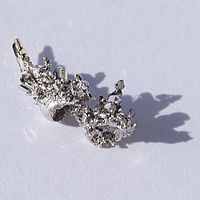
Incorporating Tantalum Oxide Nanoparticles into Implantable Polymeric Biomedical Devices for Radiological Monitoring.
Sign Up to like & getrecommendations! Published in 2023 at "Advanced healthcare materials"
DOI: 10.1002/adhm.202203167
Abstract: Longitudinal radiological monitoring of biomedical devices is increasingly important, driven by risk of device failure following implantation. Polymeric devices are poorly visualized with clinical imaging, hampering efforts to use diagnostic imaging to predict failure and… read more here.
Keywords: incorporating tantalum; biomedical devices; oxide nanoparticles; tantalum oxide ... See more keywords

Designing the Charge Storage Properties of Li‐Exchanged Sodium Vanadium Fluorophosphate for Powering Implantable Biomedical Devices
Sign Up to like & getrecommendations! Published in 2019 at "Advanced Energy Materials"
DOI: 10.1002/aenm.201900226
Abstract: The growing demand for bioelectronics has generated widespread interest in implantable energy storage. These implantable bioelectronic devices, powered by a complementary battery/capacitor system, have faced difficulty in miniaturization without compromising their functionality. This paper reports… read more here.
Keywords: storage; battery capacitor; biomedical devices; charge storage ... See more keywords

Heating/Solvent Responsive Shape-Memory Polymers for Implant Biomedical Devices in Minimally Invasive Surgery: Current Status and Challenge.
Sign Up to like & getrecommendations! Published in 2020 at "Macromolecular bioscience"
DOI: 10.1002/mabi.202000108
Abstract: This review is about the fundamentals and practical issues in applying both heating and solvent responsive shape memory polymers (SMPs) for implant biomedical devices via minimally invasive surgery. After revealing the general requirements in the… read more here.
Keywords: solvent responsive; shape memory; biomedical devices; heating solvent ... See more keywords

Multi-functional zwitterionic coating for silicone-based biomedical devices
Sign Up to like & getrecommendations! Published in 2020 at "Chemical Engineering Journal"
DOI: 10.1016/j.cej.2020.125663
Abstract: Abstract Bacteria associated infection, blood coagulation, inflammation, tissue adhesion and weak surface lubrication are major issues challenging the biomedical application (especially long-term indwelling) of silicone rubber (SR) based catheters. Here, we report a new strategy… read more here.
Keywords: silicone; zwitterionic; surface; adhesion ... See more keywords
Biaxial test and hyperelastic material models of silicone elastomer fabricated by extrusion-based additive manufacturing for wearable biomedical devices.
Sign Up to like & getrecommendations! Published in 2020 at "Journal of the mechanical behavior of biomedical materials"
DOI: 10.1016/j.jmbbm.2020.103733
Abstract: Biaxial tensile testing of the silicone elastomer fabricated by additive manufacturing (AM) for wearable biomedical devices is presented. Silicone elastomer has unique mechanical properties ideal for stretchable parts in wearable biomedical devices. Biaxial tensile testing,… read more here.
Keywords: wearable biomedical; biomedical devices; additive manufacturing; elastomer fabricated ... See more keywords

Additive manufacturing of biomedical devices: an overview
Sign Up to like & getrecommendations! Published in 2018 at "Materials Technology"
DOI: 10.1080/10667857.2017.1389052
Abstract: Abstract Additive manufacturing (AM) especially using CAD-directed laser or electron beam melting (EBM) of metal or pre-alloyed powder beds is able to produce complex, porous mesh or foam biomedical devices. Engineered pore structures are able… read more here.
Keywords: manufacturing biomedical; devices overview; bone; biomedical devices ... See more keywords

Clinical significance of three-dimensional printed biomaterials and biomedical devices.
Sign Up to like & getrecommendations! Published in 2019 at "MRS bulletin"
DOI: 10.1557/mrs.2019.121
Abstract: Three-dimensional printing (3DP) is becoming a standard manufacturing practice for a variety of biomaterials and biomedical devices. This layer-by-layer methodology provides the ability to fabricate parts from computer-aided design files without the need for part-specific… read more here.
Keywords: medicine; dimensional printed; biomedical devices; clinical significance ... See more keywords

2D nanomaterials in 3D/4D-printed biomedical devices
Sign Up to like & getrecommendations! Published in 2021 at "Journal of Materials Research"
DOI: 10.1557/s43578-021-00287-2
Abstract: Two-dimensional materials are becoming a new sensation in the chemical, electrical, energy storage, and biomedical industries. Since the invention of graphene, scientists worldwide have been attempting to explore novel 2D materials. High surface-to-volume ratio, lightweight,… read more here.
Keywords: printed biomedical; biomedical devices; nanomaterials printed;

Auxetic Metamaterials for Biomedical Devices: Current Situation, Main Challenges, and Research Trends
Sign Up to like & getrecommendations! Published in 2022 at "Materials"
DOI: 10.3390/ma15041439
Abstract: Auxetic metamaterials are characterized by a negative Poisson ratio (NPR) and display an unexpected property of lateral expansion when stretched and densification when compressed. Auxetic properties can be achieved by designing special microstructures, hence their… read more here.
Keywords: devices current; auxetic metamaterials; current situation; research ... See more keywords

Development of an Integrated Salt Cartridge-Reverse Electrodialysis (Red) Device to Increase Electrolyte Concentrations to Biomedical Devices
Sign Up to like & getrecommendations! Published in 2022 at "Membranes"
DOI: 10.3390/membranes12100990
Abstract: Emerging technologies in nanotechnology and biomedical engineering have led to an increase in the use of implantable biomedical devices. These devices are currently battery powered which often means they must be surgically replaced during a… read more here.
Keywords: reverse electrodialysis; salt; increase; cartridge ... See more keywords